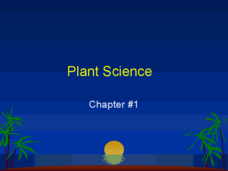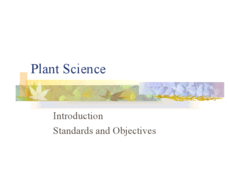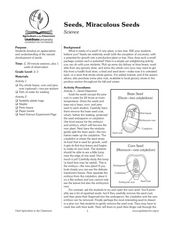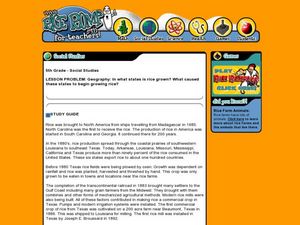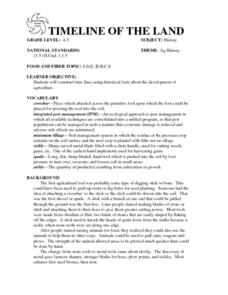Curated OER
Plant Science Chapter #1
It may not stand as a cohesive presentation, but individually you may find a use for these slides. One slide describes how civilization began once man learned to plant and harvest food. Another explores the population growth over time....
Curated OER
Plant Science Introduction
A unique PowerPoint explains the basics of plant science. It motivates viewers to study plant science and then lists different food products, biofuels, fibers, timber, and ornamental uses of plants. It concludes with lists of careers...
Curated OER
Corn An A-Maizing Plant
Fifth graders consider the uses of corn. In this agricultural lesson, 5th graders examine corn as a natural resource and discuss the many ways to reuse the grain. A variety of activities, books, and web resources are included...
Curated OER
Farm Products Help Me Grow
Learners view a display of empty food containers (or illustrations). They select a food and decide as a class if it has an animal or plant origin. Students view a display of common farm animals that are commonly eaten (cow, pig, chicken,...
Curated OER
Field Crops in the Food System
Students complete activities related to food production and distribution. For this agriculture lesson, students read and discuss the crops grown in Iowa and Wisconsin and the ways the crops are used. They complete activities related to...
Curated OER
Corn: An A-maizing Plant
Students explore the corn crop. In this farming lesson, students identify which states are in the corn belt and read about the history of corn, its uses and its development and growth. Students dissect a corn kernel. Students discuss the...
Curated OER
Food Travels and Preservation
Young scholars complete a worksheet. In this food distribution and preservation lesson, students learn about the transportation of agricultural projects. Young scholars list foods that they buy at the grocery store and then identify how...
Curated OER
Rice: The Global Crop
Students understand the uniqueness of the rice plant and how it grows. Students compare rice growing in Indonesia and California, observing the steps common to the process everywhere. Students comprehend the concepts labor-intensive and...
Curated OER
Making Pretzels
Students discover that plants provide food products to humans. In this baking lesson, students grind wheat seeds into flour and then use the flour to make pretzels. Students participate in a variety of activities that involve them in...
Curated OER
Listening to the Prairie
Students, in groups, visit an exhibit and for a prairie scavenger hunt to locate sunflowers and name products made from them. After sketching a prairie dog, they find nature cues farmers use when growing plants and raising animals. The...
Curated OER
Seeds, Miraculous Seed
Students investigate relationships between plants and animals and how living things change during their lives. In this life cycle lesson, students split different types of seeds apart to see the beginning life stages of future plants.
Curated OER
How Many Hats Does a Farmer Wear
In this farmer worksheet, students make a spinning wheel to describe the jobs of a farmer. Students create 1 wheel with 8 different jobs for a farmer.
Curated OER
Economics
Fourth graders read a poem about rice and identify its importance around the world. In this rice lesson, 4th graders read about the role of rice in various nutritional sectors around the world. Students complete two word problems about...
Curated OER
Where is Rice Grown?
Fifth graders create a timeline of the development of rice as an important crop. In this agricultural history instructional activity, 5th graders read about the history behind why rice was grown and where it is grown. Students...
Curated OER
Hunting, Farming and Market Gardening
Students examine the hunting and farming practices of the Black Pioneer. They identify crops raised by black pioneers, and explore the contribution of children to the success of the family farm. Students explore the importance of...
Curated OER
TIMELINE OF THE LAND
Students construct time lines using historical facts about the development of agriculture. Students research specific dates and events and report their findings to the class. Students tape or glue the sections together sequentially in a...
